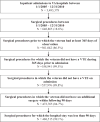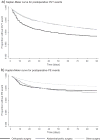Using multiple sources of data for surveillance of postoperative venous thromboembolism among surgical patients treated in Department of Veterans Affairs hospitals, 2005-2010
- PMID: 25666908
- PMCID: PMC4453876
- DOI: 10.1016/j.thromres.2015.01.026
Using multiple sources of data for surveillance of postoperative venous thromboembolism among surgical patients treated in Department of Veterans Affairs hospitals, 2005-2010
Abstract
Background: There are limitations to using administrative data to identify postoperative venous thromboembolism (VTE). We used a novel approach to quantify postoperative VTE events among Department of Veterans Affairs (VA) surgical patients during 2005-2010.
Methods: We used VA administrative data to exclude patients with VTE during 12 months prior to surgery. We identified probable postoperative VTE events within 30 and 90 days post-surgery in three settings: 1) pre-discharge inpatient, using a VTE diagnosis code and a pharmacy record for anticoagulation; 2) post-discharge inpatient, using a VTE diagnosis code followed by a pharmacy record for anticoagulation within 7 days; and 3) outpatient, using a VTE diagnosis code and either anticoagulation or a therapeutic procedure code with natural language processing (NLP) to confirm acute VTE in clinical notes.
Results: Among 468,515 surgeries without prior VTE, probable VTEs were documented within 30 and 90 days in 3,931 (0.8%) and 5,904 (1.3%), respectively. Of probable VTEs within 30 or 90 days post-surgery, 47.8% and 62.9%, respectively, were diagnosed post-discharge. Among post-discharge VTE diagnoses, 86% resulted in a VA hospital readmission. Fewer than 25% of outpatient records with both VTE diagnoses and anticoagulation prescriptions were confirmed by NLP as acute VTE events.
Conclusion: More than half of postoperative VTE events were diagnosed post-discharge; analyses of surgical discharge records are inadequate to identify postoperative VTE. The NLP results demonstrate that the combination of VTE diagnoses and anticoagulation prescriptions in outpatient administrative records cannot be used to validly identify postoperative VTE events.
Keywords: Deep vein thrombosis; Pulmonary embolism; Surgery; Venous thromboembolism; Veterans.
Copyright © 2015. Published by Elsevier Ltd.
Figures
Similar articles
-
Risk of Post-Discharge Venous Thromboembolism and Associated Mortality in General Surgery: A Population-Based Cohort Study Using Linked Hospital and Primary Care Data in England.PLoS One. 2015 Dec 29;10(12):e0145759. doi: 10.1371/journal.pone.0145759. eCollection 2015. PLoS One. 2015. PMID: 26713434 Free PMC article.
-
Association Between Inpatient Surveillance and Venous Thromboembolism Rates After Hospital Discharge.JAMA Surg. 2015 Jun;150(6):520-7. doi: 10.1001/jamasurg.2015.35. JAMA Surg. 2015. PMID: 25831412
-
Effect of post-discharge venous thromboembolism on hospital quality comparisons following hip and knee arthroplasty.J Bone Joint Surg Am. 2014 Sep 3;96(17):1476-84. doi: 10.2106/JBJS.M.01248. J Bone Joint Surg Am. 2014. PMID: 25187587
-
Venous thromboembolic events in patients undergoing craniotomy for tumor resection: incidence, predictors, and review of literature.J Neurosurg. 2019 Jan 4;132(1):10-21. doi: 10.3171/2018.7.JNS181175. Print 2020 Jan 1. J Neurosurg. 2019. PMID: 30611138 Free PMC article. Review.
-
A narrative review on the epidemiology, prevention, and treatment of venous thromboembolic events in the context of chronic venous disease.J Vasc Surg Venous Lymphat Disord. 2021 Nov;9(6):1557-1567. doi: 10.1016/j.jvsv.2021.03.018. Epub 2021 Apr 16. J Vasc Surg Venous Lymphat Disord. 2021. PMID: 33866055 Review.
Cited by
-
Impact of Perioperative Thromboembolic Complications on Future Long-term Risk of Venous Thromboembolism among Medicare Beneficiaries Undergoing Complex Gastrointestinal Surgery.J Gastrointest Surg. 2021 Dec;25(12):3064-3073. doi: 10.1007/s11605-021-05080-4. Epub 2021 Jul 19. J Gastrointest Surg. 2021. PMID: 34282525
-
A taxonomy for advancing systematic error analysis in multi-site electronic health record-based clinical concept extraction.J Am Med Inform Assoc. 2024 Jun 20;31(7):1493-1502. doi: 10.1093/jamia/ocae101. J Am Med Inform Assoc. 2024. PMID: 38742455 Free PMC article.
-
The significance of perioperative coagulation and fibrinolysis related parameters after lung surgery for predicting venous thromboembolism: a prospective, single center study.J Thorac Dis. 2018 Apr;10(4):2223-2230. doi: 10.21037/jtd.2018.03.174. J Thorac Dis. 2018. PMID: 29850126 Free PMC article.
-
Precaution Costs: The Presumption of Breast Cancer Seeding and Its Impact on Surgical Expenditure.Plast Reconstr Surg Glob Open. 2020 Jun 18;8(6):e2903. doi: 10.1097/GOX.0000000000002903. eCollection 2020 Jun. Plast Reconstr Surg Glob Open. 2020. PMID: 32766056 Free PMC article.
-
Trends and Risk Factors for Venous Thromboembolism Among Hospitalized Medical Patients.JAMA Netw Open. 2022 Nov 1;5(11):e2240373. doi: 10.1001/jamanetworkopen.2022.40373. JAMA Netw Open. 2022. PMID: 36409498 Free PMC article.
References
-
- Hooper WC, Evatt BL. The role of activated protein C resistance in the pathogenesis of venous thrombosis. Am J Med Sci. 1998;316:120–8. - PubMed
-
- Piazza G, Goldhaber SZ. Venous thromboembolism and atherothrombosis: an integrated approach. Circulation. 2010;121:2146–50. - PubMed
-
- Heit JA, Silverstein MD, Mohr DN, Petterson TM, Lohse CM, O’Fallon WM, et al. The epidemiology of venous thromboembolism in the community. Thromb Haemost. 2001;86:452–63. - PubMed
Publication types
MeSH terms
Grants and funding
LinkOut - more resources
Full Text Sources
Other Literature Sources
Medical



